2007 年天津工业大学基础英语汉语考研真题
I. Vocabulary and Structure
Directions: Fill in the following blanks by choosing A, B, C or D. There is only
ONE answer for each
blank, write the letter A, B, C or D on the ANSWER SHEET.
1. The tulip grower owns a house in Iceland, 50-acre vineyard in France and two luxury
_____
moored at a harbour in Spain.
A. yachts B. woodpeckers C. visas D. steeds
2. It’s better to be happy with what you have got than to be always ______ towards
something you can’t have.
A. wringing B. wrestling C. zooming D. yearning
3. I give you my ______ that I’ll never mention the matter again.
A. utterance B. word C. underwriter D. latent
4. Wheat, rice, corn, and oats are ______.
A. pancakes B. pickles C. cereals D. luncheons
5. Neither the monk nor the nuns were utterly _______ witnesses because they had
not seen the
accident themselves.
A. dogmatic B. credible C. serial D. open-minded
6. The tradesman was arrested after being discovered with packets of cocaine sewn
into the ______ of his cap.
A. timing B. telexing C. typewriting D. lining
7. Rather than enhancing a country’s security, the successful development of nuclear
weapons could serve at first to increase that country’s ______.
A. vulnerability B. boldness C. responsibility D. influence
8. She was on _______ for a long time after her husband passed away.
A. tumour B. twilight C. twig D. tranquilizer
9. He dropped a _______ on us on the first of March when he told us that we were
bankrupt.
A. warship B. fireplace C. thunderbolt D. poppy
10. All of the following are nice food except the ________.
A. muffin B. pudding C. pineapple D. sweetheart
11. A ______ is the office or people responsible for the management of an organization,
particularly an international or political one, such as the United Nations.
A. showcase B. signpost C. secretariat D. lookout
12. The Prime Minister of the United Kingdom was received with all the traditional
______ and
ceremony that is laid on for visiting heads of government.
A. pomp B. sunflower C. sunlight D. fever
13. The bees carry the _______ from one flower to another.
�
A. honeymoon B. pollen C. petal D. pier
14. The _______ is usually put on top of the postage stamp so that the stamp cannot
be used more than once.
A. post-office B. personage C. postmark D. prose
15. An investigation that is _______ can occasionally yield new facts, even notable
ones, but typically the appearance of such facts is the result of a search in a
definite direction.
A. uncomplicated B. subjective C. unguided D. timely
16. The _______ stretches as far as the eye can see.
A. portfolio B. prairie C. earthworm D. electrode
17. The natural balance between prey and predator has been increasingly _______,
most frequently by human intervention.
A. disturbed B. celebrated C. questioned D. observed
18. In that war thousands and thousands of people were put to the _______.
A. yearbook B. sword C. walnut D. witch
19. Do you see _______ cloud that is almost in the shape of a clown?
A. audio B. dwarf C. weighty D. yonder
20. In Britain, judges wear white _______ in court.
A. wigs B. willows C. widower D. whirlwind
II. Reading Comprehension Part One
Directions: Read the following passage and write T for True if the statement is
true, F for False if the statement is not true based on the passage you have read.
Write your answers on the ANSWER
SHEET.
Dreams have always held a universal fascination. Some primitive societies believe
that the soul
leaves the body and visits the scene of the dream. Generally, however, dreams are
accepted to be illusions, having much in common with day-dreams
the fantasies of
our waking life. When
dreaming, however, one tends to believe fully in the reality of the dream world,
however inconsistent, illogical and odd it may be.
Although most dreams apparently happen spontaneously, dream activity may be
provoked by
external
breathing
difficulties of a heavy cold, for instance. Internal disorders such as indigestion
can cause vivid dreams, and dreams of racing fire-engines may be caused by the
ringing of an alarm bell.
Experiments have been carried out to investigate the connection between
deliberately inflicted
pain and dreaming. For example, a sleeper pricked with a pin perhaps dreams of
fighting a battle and receiving a severe sword wound. Although the dream is
stimulated by the physical discomfort, the actual events of the dream depend on
the associations of the discomfort in the mind of the sleeper.
A dreamer’s eyes often move rapidly from side to side. Since people born blind
influences.Suffocation
connected
with
the
dreams
are
�
do not dream
visually and do not manifest this eye activity, it is thought that the dreamer may
be scanning the scene depicted in his dream. A certain amount of dreaming seems
to be a human requirement if a sleeper is roused every time his eyes begin to move
fast, effectively depriving him of his dreams, he will make more eye movements the
following night.
People differ greatly in their claims to dreaming. Some say they dream every night,
others only
very occasionally. Individual differences probably exist, but some people
immediately forget dreams and others have good recall.
Superstition and magical practices thrive on the supposed power of dreams to
foretell the future. Instances of dreams which have later turned out to be prophetic
have often been recorded, some by men of the highest intellectual integrity.
Although it is better to keep an open mind on the subject, it is true that the alleged
power of dreams to predict future events still remains unproved.
Everyone knows that a sleeping dog often behaves as though he were dreaming, but
it is
impossible to tell what his whines and twitches really mean. By analogy with human
experience,
however, it is reasonable to suppose that at least the higher animals are capable
of dreaming. Of the many theories of dreams, Freud’s is probably the best known.
According to Freud, we revert in our dreams to the modes of thought characteristic
of early childhood. Our thinking becomes concrete, pictorial, and non-logical, and
expresses ideas and wishes we are no longer conscious of. Dreams are absurd and
unaccountable because our conscious mind, not willing to acknowledge our
subconscious ideas, disguises them. Some of Freud’s interpretations are extremely
fanciful, but there is almost certainly some truth in his view that dreams express
the subconscious mind.
21.____ A sleeper pricked with a pin may dream that he has been stabbed.
22.____ Sighted people and those who have never been able to see dream in exactly
the same way.
23.____ There is plenty of proof available that dreams foretell the future.
24.____ Dreams in sleep are quite different from day-dreams.
25.____ Dreams may be caused by an upset stomach.
26.____ Dreaming is probably unnecessary.
27.____ Everyone knows that dogs dream just like human beings.
28.____ Because human beings dream, so may the more intelligent animals.
29.____ Dreams are not easy to interpret because the original thoughts and ideas
are disguised.
30.____ It is almost certainly true that dreams express the subconscious mind.
Part Two
Directions: Read the following passages and choose A, B, C or D for the correct
answer for each
question. There is only ONE answer for each question, write the letter A, B, C or
�
D on the ANSWER
SHEET.
Passage One
Why should anyone buy the latest volume in the ever-expanding Dictionary of National
Biography? I do not mean that it is bad, as the reviewers will agree. But it will
cost you 65 pounds. And have you got the rest of volumes? You need the basic 22
plus the largely decennial supplements
to bring the total to 31. Of course, it will be answered, public and academic
libraries will want the new volume. After all, it adds 1,068 lives of people who
escaped the net of the original compilers. Yet in 10 years’ time a revised version
of the whole caboodle, called the New Dictionary of National Biography, will be
published. Its editor, professor Colin Matthew, tells me that he will have room
for about 50,000 lives, some 13,000 more than in the current DNB. This rather puts
the 1,068 in Missing Persons in the shade.
When Dr. Nicholls wrote to The Spectator in 1989 asking for names of people whom
readers had
looked up in the DNB and had been disappointed not to find, she says that she received
some 100,000
suggestions. ( Well, she had written to “other quality newspapers”, too. ) As
soon as her committee had whittled the numbers down, the professional problems of
an editor began. Contributors didn’t file copy on time; some who did sent too much:
50,000 words instead of 500 is a record, according to Dr.
Nicholls.
There remains the dinner-party game of who’s in, who’s out. That is a game that
the reviewers
have played and will continue to play. Criminals were my initial worry. After all,
the original edition of the DNB boasted: Malefactors whose crimes excite a permanent
interest have received hardly less
attention than benefactors. Mr. John Gross clearly had similar anxieties, for he
complains that, while the murderer Christie is in, Crippen is out. One might say
in reply that the injustice of the hanging of Evans instead of Christie was a force
in the repeal of capital punishment in Britain, as Ludovie Kennedy ( the author
of Christie’s entry in Missing Persons ) notes. But then Crippen was reputed as
the first murderer to be caught by telegraphy ( he had tried to escape by ship to
America).
It is surprising to find Max Miller excluded when really not very memorable names
get in. There
has been a conscious effort to put in artists and architects from the Middle Ages.
About their lives not
much is always known.
Of Hugo of Bury St Edmunds, a 12th-century illuminator whose dates of birth and
death are not
recorded, his biographer comments: “Whether or not Hugo was a wall-painter, the
records of his activities as carver and manuscript painter attest to his
�
versatility.” Then there had to be more women, too ( 12 per cent, against the
original DBN’s 3 ), such as Roy Strong’s subject, the Tudor painter Levina Teerlinc,
of whom he remarks: “Her most characteristic feature is a head attached to a too
small, spindly body. Her technique remained awkward, thin and often cursory.” It
doesn’t seem toqualify her as a memorable artist. Yet it may be better than the
record of the original DNB, which
included lives of people who never existed ( such as Merlin ) and even managed to
give thanks to J. W.Clerke as a contributor, though, as a later edition admits a
shamefaced footnote, “except for the entry in the List of contributors there is
no trace of J. W. Clerke.”
31. The writer suggests that there is no sense in buying the latest volume ________.
A. because it is not worth the price
B. because it has fewer entries than before
C. unless one has all the volumes in his collection
D. unless an expanded DNB will come out shortly
32. On the issue of who should be included in the DNB, the writer seems to suggest
that ________.
A. the editors had clear rules to follow
B. there were too many criminals in the entries
C. the editors clearly favored benefactors
D. the editors were irrational in their choices
33. Crippen was absent from the DNB ________.
A. because he escaped to the U.S.
B. because death sentence had been abolished
C. for reasons not clarified
D. because of the editors’ mistake
34. The author quoted a few entries in the last paragraph to ________.
A. illustrate some features of the DNB
B. give emphasis to his argument
C. impress the reader with its content
D. highlight the people in the Middle Ages
35. Throughout the passage, the writer’s tone towards the DNB was ________.
A. complimentary B. supportive C. sarcastic D. bitter
Passage Two
When literary periods are defined on the basis of men’s writing, women’s writing
must be
forcibly assimilated into an irrelevant grid: a Renaissance that is not a Renaissance
for women, a
Romantic period in which women played very little part, a Modernism with which women
conflict. Simultaneously, the history of women’s writing has been suppressed,
leaving large, mysterious gaps in accounts of the development of various genres.
Feminist criticism is beginning to correct this situation. Margaret Anne Doody, for
example, suggests that during “the period between the death of Richardson and the
appearance of the novels of Scott and Austen,” which has “been regarded as dead
�
period.”
Late-eighteenth-century women writers actually developed “the paradigm for women’
s fiction of the nineteenth century ❭
something hardly less than the paradigm of
the nineteenth-century novel itself.” Feminist critics have also pointed out that
the twentieth-century writer Virginia Woolf belonged to a tradition other than
modernism and that this tradition surfaces in her work precisely where criticism
has hitherto found obscurities, evasions, implausibilities, and imperfections.
36. It can be inferred from the passage that the author views the division of
literature into periods based on men’s writing as an approach that _______.
A. makes distinctions among literary periods ambiguous
B. was misunderstood until the advent of feminist criticism
C. provides a valuable basis from which feminist criticism has evolved
D. obscures women’s contributions to literature
37. The passage suggests which of the following about Virginia Woolf’s work?
I. Nonfeminist criticism of it has been flawed.
II. Critics have treated it as part of modernism.
III. It is based on the work of late-eighteenth century women writers.
A. I only
B. II only
C. I and II only
D. II and III only
38. The author quotes Doody most probably in order to illustrate _______.
A. a contribution that feminist criticism can make to literary criticism
B. a modernist approach that conflicts with women’s writing
C. writing by a woman which had previously been ignored
D. the hitherto overlooked significance of Scott’s and Austen’s novels
39. The passage provides information that answers which of the following questions?
A. In what tradition do feminist critics usually place Virginia Woolf?
B. What are the main themes of women’s fiction of the nineteenth century?
C. What events motivated the feminist reinterpretation of literary history?
D. How has the period between Richardson’s death and Scott’s and Austen’s novels
traditionally
been regarded by critics?
Passage Three
Investigators of monkeys’ social behavior have always been struck by monkeys’
aggressive
potential and the consequent need for social control of their aggressive behavior.
Studies directed at describing aggressive behavior and the situations that elicit
it, as well as the social mechanisms that control it, were therefore among the first
investigations of monkeys’ social behavior.
Investigators initially believed that monkeys would compete for any resource in
the environment; hungry monkeys would fight over water, and, in general, and time
more than one monkey in a group sought the same incentive simultaneously, a dispute
would result and would be resolved through some form of aggression. However, the
�
motivating force of competition for incentives began to be doubted when experiments
like Southwick’s on the reduction of space or the withholding of food failed to
produce more than temporary increases in intragroup aggression. Indeed, food
deprivation not only failed to increase aggression but in some cases actually
resulted in decreased frequencies of aggression.
Studies of animals in the wild under conditions of extreme food deprivation likewise
revealed
that starving monkeys devoted almost all available energy to foraging, with little
energy remaining for aggressive interaction. Furthermore, accumulating evidence
from later studies of a variety of primate groups, for example, the study conducted
by Bernstein, indicates that one of the most potent stimuli for eliciting aggression
is the introduction of an intruder into an organized group. Such introductions result
in far more serious aggression than that produced in any other types of experiments
contrived to produce competition.
These studies of intruders suggest that adult members of the same species introduced
to one
another for the first time show considerable hostility because, in the absence of
a social order, one must be established to control interanimal relationships. When
a single new animal is introduced into
an existing social organization, the newcomer meets even more serious aggression.
Whereas in the first case aggression establishes a social order, in the second case
resident animals mob the intruder, thereby initially excluding the new animal from
the existing social unit. The simultaneous
introduction of several animals lessens the effect, if only because the group divides
its attention
among the multiple targets. If, however, the several animals introduced into a group
constitute their own social unit, each group may fight the opposing group as a unit;
but, again, no individual is subjected to mass attack, and the very cohesion of the
groups precludes prolonged individual combat.
The submission of the defeated group, rather than unleashing unchecked aggression
on the part of the victorious group, reduces both the intensity and frequency of
further attack. Monkey groups therefore seem to be organized primarily to maintain
their established social order rather than to engage in hostilities per se.
40. The author of the passage is primarily concerned with ______.
A. advancing a new methodology for changing a monkey’s social behavior
B. comparing the methods of several research studies on aggression among monkeys
C. explaining the reasons for researchers’ interest in monkeys’ social behavior
D. discussing the development of investigators’ theories about aggression among
monkeys
41. Which of the following best summarizes the findings reported in the passage about
the effect of food deprivation on monkeys’ behavior?
A. Food deprivation has no effect on aggression among monkeys.
B. Food deprivation increases aggression among monkeys because one of the most
potent stimulifor eliciting aggression is the competition for incentives.
�
C. Food deprivation may increase long-term aggression among monkeys in a laboratory
setting,
but it produces only temporary increases among monkeys in the wild
D. Food deprivation may temporarily increase aggression among monkeys, but it also
leads to a
decrease in conflict.
42. According to the author, studies such as Southwick’s had which of the following
effects on investigators’ theories about monkeys’ social behavior?
A. They confirmed investigators’ theories about monkeys’ aggressive response to
competition for food and water.
B. They cast doubt on investigators’ theories that could account for observed
patterns of aggression among monkeys.
C. They disproved investigators’ theory that the introduction of intruders in an
organized monkey group elicits intragroup aggressive behavior.
D.They confirmed investigators ’ beliefs about the motivation for continued
aggression among monkeys in the same social group.
43.The passage suggests that investigators of monkeys’ social behavior have been
especially interested in aggressive behavior among monkeys because________.
A. aggression is the most common social behavior among monkeys
B. most monkeys are potentially aggressive, yet they live in social units that could
not function
without control of their aggressive impulses
C. situations that elicit aggressive behavior can be studied in a laboratory
D. successful competition for incentives determines the social order in a monkey
group
44. It can be inferred from the passage that the establishment and preservation of
social order among a group of monkeys is essential in order to ________.
A. keep the monkeys from straying and joining in other groups
B. control aggressive behavior among group members
C. protect individuals seeking to become members of that group from mass attack
D. prevent the domination of that group by another
45. Which of the following best describes the organization of the second paragraph?
A. A hypothesis is explained and counter evidence is described.
B. A theory is advanced and specific evidence supporting it is cited.
C. Field observations are described and a conclusion about their significance is
drawn.
D. Two theories are explained and evidence supporting each of them is detailed.
III. Cloze
Directions: Read the following passage and try to fill in each of the numbered spaces
with ONE
suitable word. Write your answer on the ANSWER SHEET.
Emotional Intelligence Test
For decades, a lot of emphasis has been put on the certain aspects of intelligence,
such as logical
�
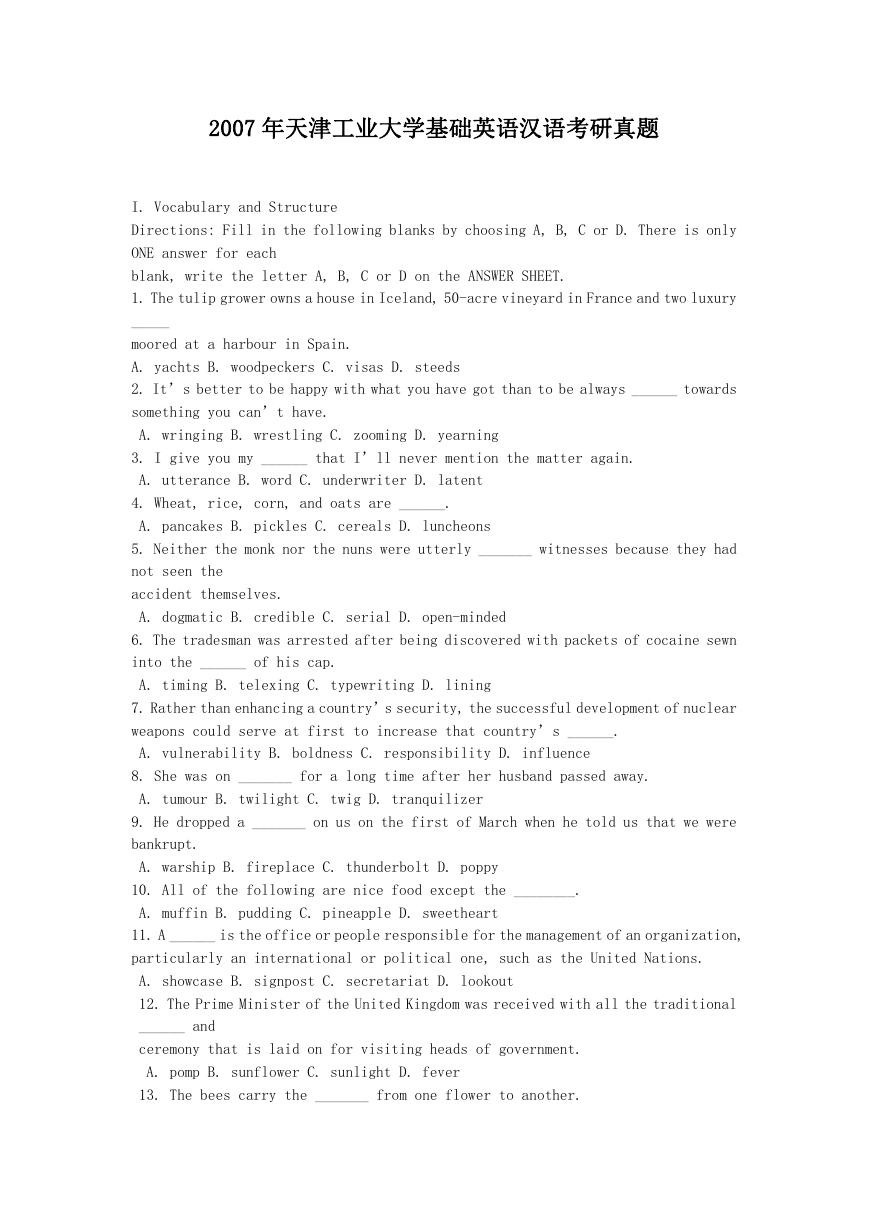
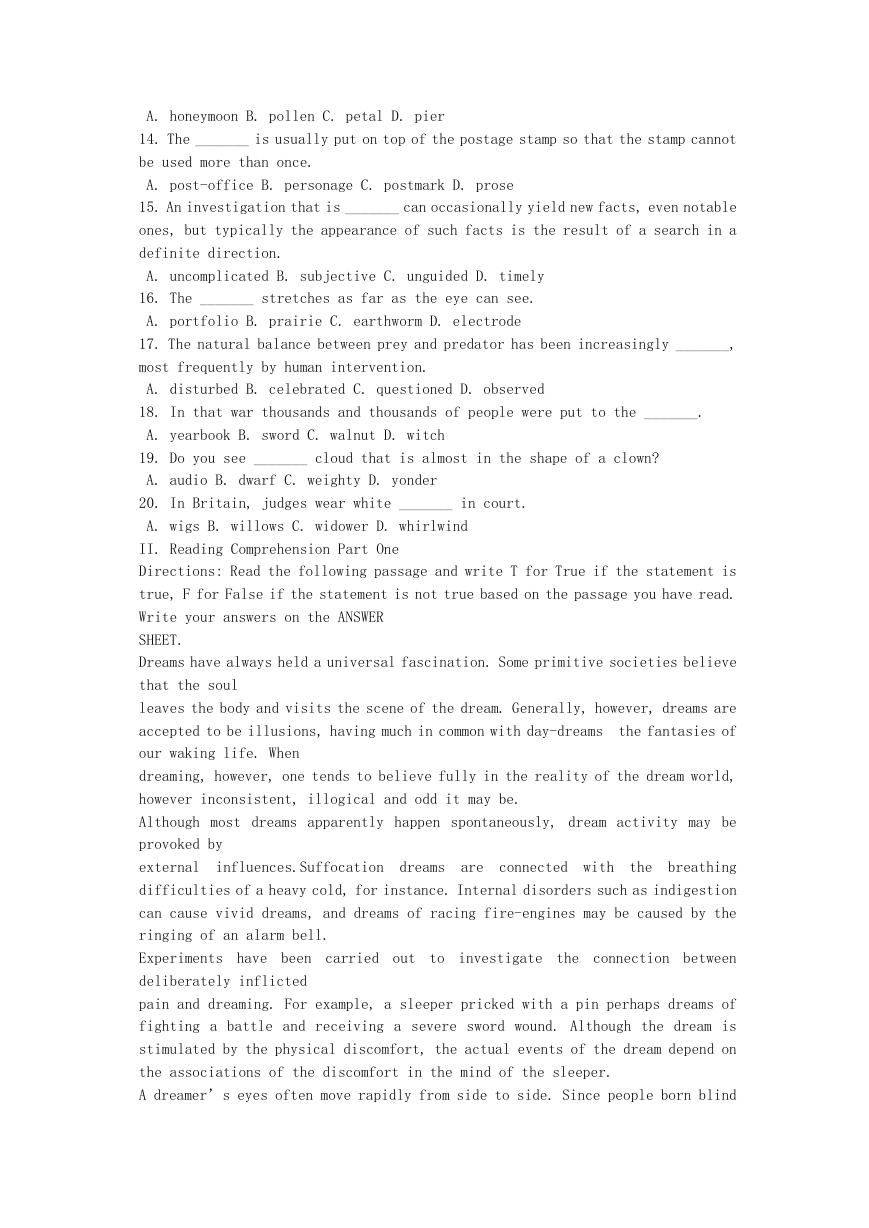
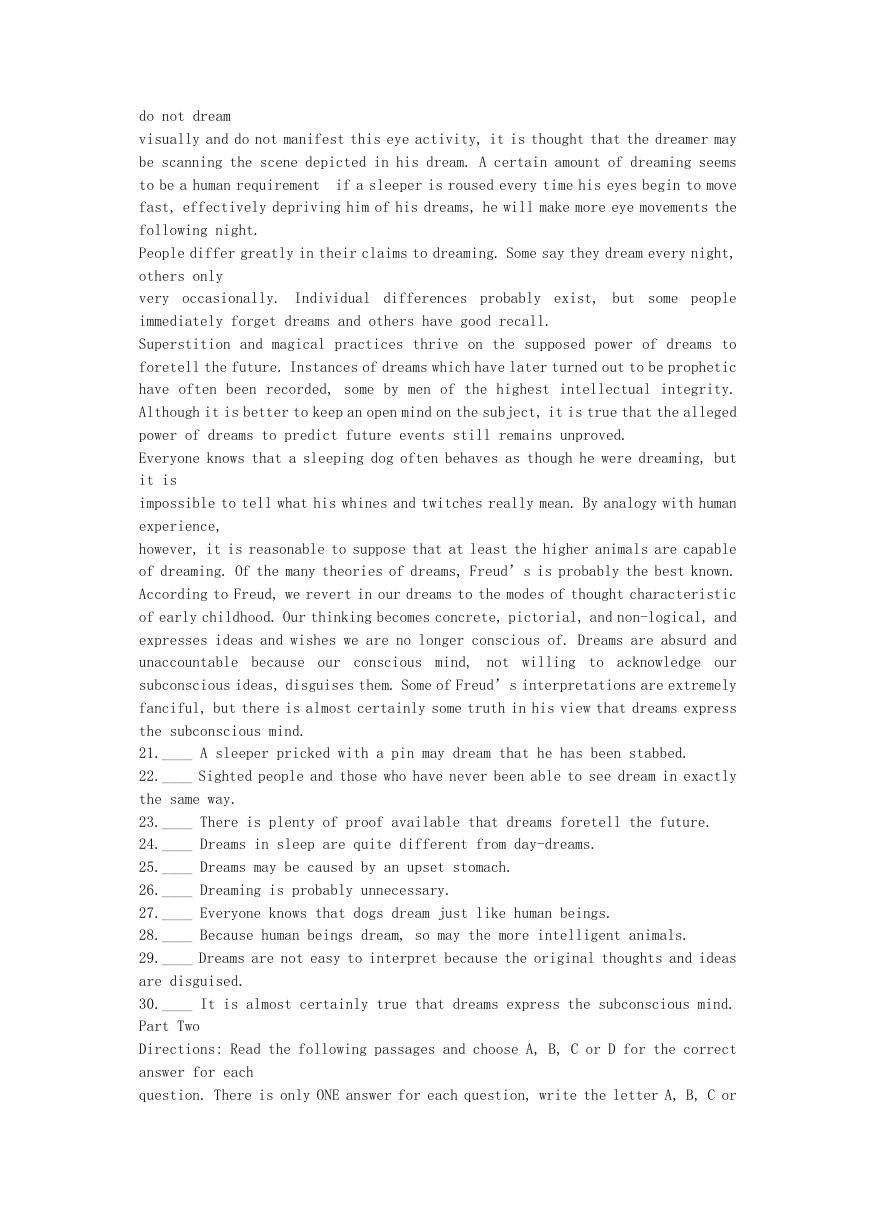
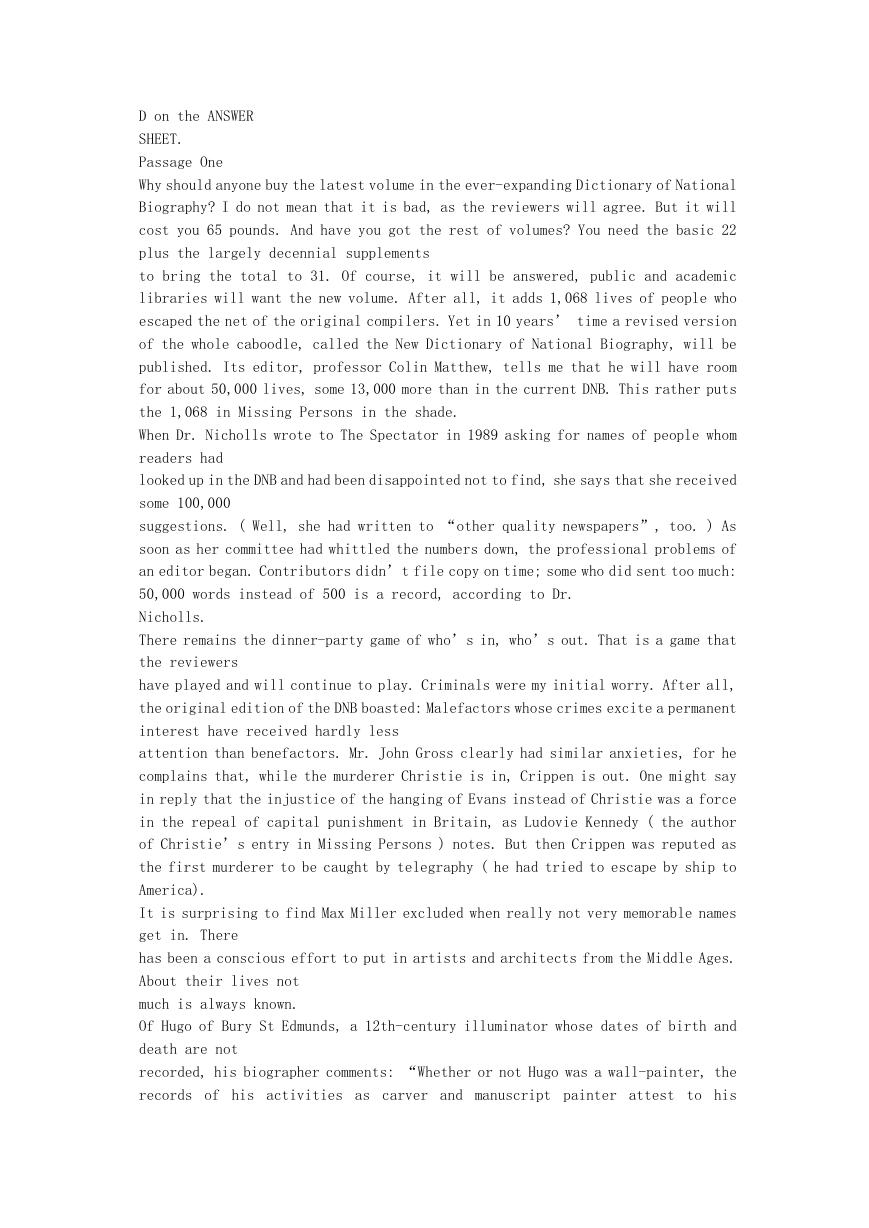

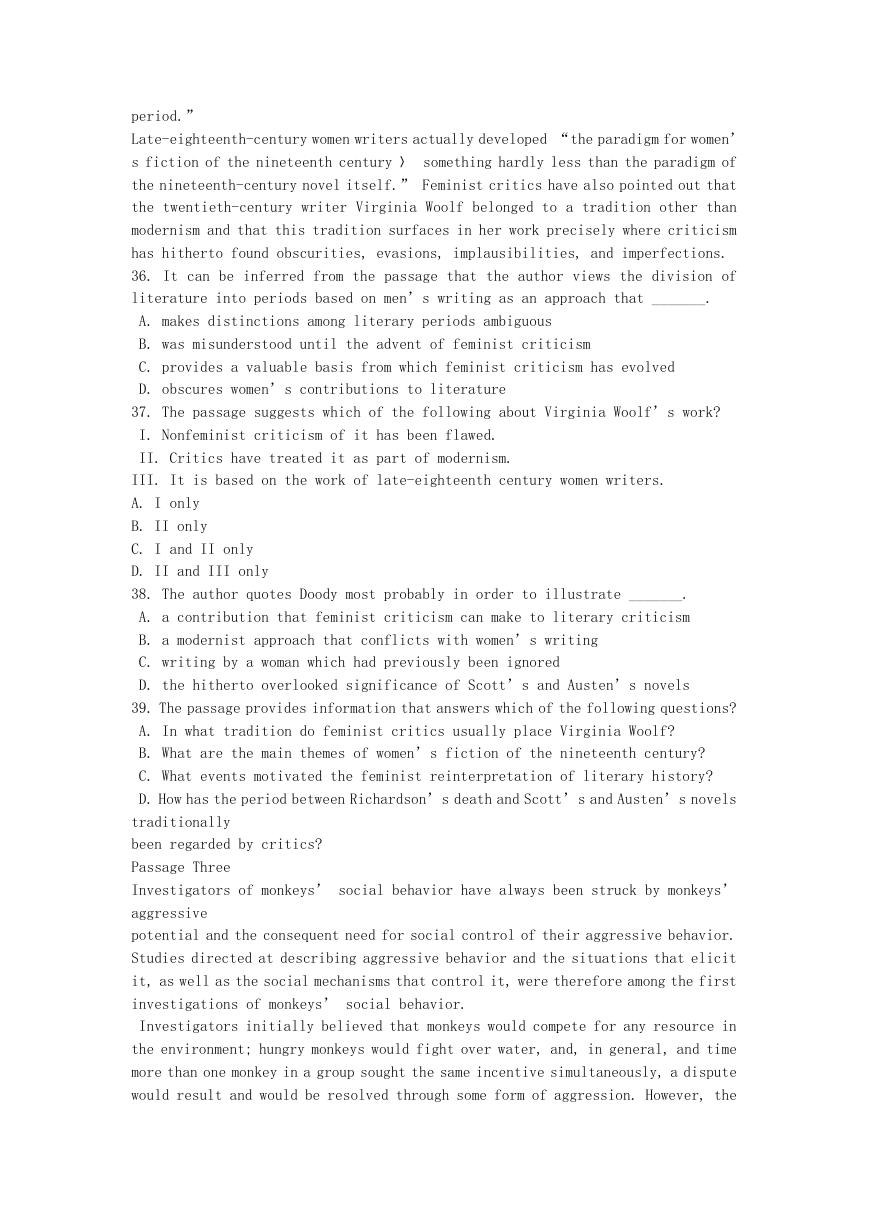










 2023年江西萍乡中考道德与法治真题及答案.doc
2023年江西萍乡中考道德与法治真题及答案.doc 2012年重庆南川中考生物真题及答案.doc
2012年重庆南川中考生物真题及答案.doc 2013年江西师范大学地理学综合及文艺理论基础考研真题.doc
2013年江西师范大学地理学综合及文艺理论基础考研真题.doc 2020年四川甘孜小升初语文真题及答案I卷.doc
2020年四川甘孜小升初语文真题及答案I卷.doc 2020年注册岩土工程师专业基础考试真题及答案.doc
2020年注册岩土工程师专业基础考试真题及答案.doc 2023-2024学年福建省厦门市九年级上学期数学月考试题及答案.doc
2023-2024学年福建省厦门市九年级上学期数学月考试题及答案.doc 2021-2022学年辽宁省沈阳市大东区九年级上学期语文期末试题及答案.doc
2021-2022学年辽宁省沈阳市大东区九年级上学期语文期末试题及答案.doc 2022-2023学年北京东城区初三第一学期物理期末试卷及答案.doc
2022-2023学年北京东城区初三第一学期物理期末试卷及答案.doc 2018上半年江西教师资格初中地理学科知识与教学能力真题及答案.doc
2018上半年江西教师资格初中地理学科知识与教学能力真题及答案.doc 2012年河北国家公务员申论考试真题及答案-省级.doc
2012年河北国家公务员申论考试真题及答案-省级.doc 2020-2021学年江苏省扬州市江都区邵樊片九年级上学期数学第一次质量检测试题及答案.doc
2020-2021学年江苏省扬州市江都区邵樊片九年级上学期数学第一次质量检测试题及答案.doc 2022下半年黑龙江教师资格证中学综合素质真题及答案.doc
2022下半年黑龙江教师资格证中学综合素质真题及答案.doc